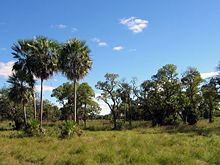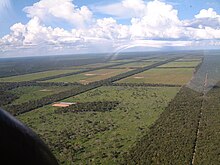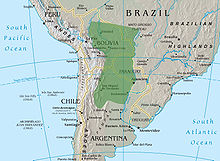Gran Chaco

The Gran Chaco or short Chaco is a region with dry forests and thorn bush savannah inside South America . It includes the north of Argentina , the western part of Paraguay and the southeast of Bolivia . Its eastern border is formed by the Río Paraná and Río Paraguay , while its western border extends from north to south from Santa Cruz de la Sierra (Bolivia) via Santiago del Estero (Argentina) to Córdoba .
In the south the Chaco merges almost imperceptibly into the pampas , in the west it borders on the rainforests of the Yungas . Behind the rivers forming the eastern border begins a slightly hilly, partly swampy grassland. The name Chaco comes from the indigenous Quechua language and was derived from chaku for "battue" or chaqu for "treeless plain".
The climate is tropical to subtropical. The summers are hot and humid, the winters moderately warm and sometimes very dry. The heat pole of South America lies in the Chaco , namely in Rivadavia in Argentina (+48.7 ° C). While the east of the Chaco has a relatively humid climate, the west is much drier and there are frequent droughts in the winter months.
population
The Gran Chaco is a very sparsely populated area, especially in the north and west, that can only be used as pastureland to a limited extent. In the south, in the Argentine part, the population is much more dense. The so-called Jesuit reductions are characteristic of the area . In the past, Guaraní were Christianized and settled in the vicinity of these mission stations . Many Mennonites of German origin have also settled in the Gran Chaco. There is traditionally a good relationship between German-speaking Mennonites and the indigenous population of the Chaco, which can also be attributed to the distrust of Spanish-speaking Paraguayans that arose during the Spanish colonial period.
Many descendants of various indigenous peoples still live in the Chaco today, most of them belong to the Tupí - Guaraní language family, such as the Chiriguano and Chané in northern Argentina. The Wichí and Toba in the border area between Argentina and Paraguay do not belong to the Guaraní . On the other hand, the Paraguayan Abipón ethnic group has died out today .
In the Paraguayan Chaco, the number of uncontacted, nomadic indigenous people is estimated at a total of 50–150 individuals, especially in the Defensores del Chaco National Park.
history
The state affiliation of the region had been disputed between Argentina, Bolivia and Paraguay since the independence of the Latin American colonies.
In 1870 Paraguay had to cede the southern part of the Gran Chaco (between the rivers Bermejo and Pilcomayo ) to Argentina after the lost Triple Alliance War .
The Gran Chaco was the scene of the bloody Chaco War between Paraguay and Bolivia from 1932 to 1935 , which was sparked by rumors of extensive oil reserves. Paraguay won the war and received most of the northern Gran Chaco from Bolivia. However, the test drillings that were soon carried out were unsuccessful.
Land use today

The Chaco is largely a plain with deep sedimentary soils . The predominantly very fertile soils are favorable for many types of agricultural use. In contrast, in large parts of the central Chaco there is a lack of fresh groundwater and in the western Chaco there is an arid climate.
The indigenous peoples of the Gran Chaco live mainly from hunting, gathering and fishing. The white settlers (criollos) who have been living there since the last century, on the other hand, practice extensive pasture farming in combination with arable farming. The different ways of life lead to conflicts, as the forest - the livelihood of the indigenous people - is increasingly being destroyed by the cattle and goats. This is especially true for the Argentine part of the Gran Chaco.
In the last few decades the country has been increasingly developed by large farms and in some cases intensively used for agriculture. The agricultural front is currently spreading rapidly into the drier areas of the Gran Chaco. The focus is on planting huge monocultures, for example soy, for export. The cultivation of jatropha for biodiesel in the drier regions is new .
The livelihoods of some still nomadic indigenous groups are threatened by the often illegal clearing. In many places, the indigenous people see their basic right to food being violated. On the Argentine side, there have been numerous - in some cases still pending - legal conflicts over the past twenty years, which have reached the Inter-American Human Rights Authority.
fauna
The dry forests of the Gran Chaco are populated by various armadillos , peccaries and deer. The Chaco peccary is characteristic , a species that was only discovered in the recent past and for a long time was only known from Pleistocene fossils. The largest wild animal in the region is the lowland tapir . The guanaco was once abundant and is now rare in the region. The largest predator of the Gran Chaco is the jaguar . A large population of this cat, as well as pumas and ocelots, are found in the huge Kaa-Iya del Gran Chaco National Park in southern Bolivia. Pampas foxes and maikongs are the most common types of dogs. Forest dogs have been found in Kaa-Iya, and maned wolves are found in the Copo National Park in Argentina.
Geographical breakdown
The Chaco is divided into three zones. The geographic and climatic conditions of the Chaco favor a diversity of fauna and flora that creates a special ecosystem.
Chaco Bajo
The Lower Chaco stretches along the west bank of the Río Paraná and Río Paraguay between Santa Fe in Argentina and Pedro Juan Caballero in Paraguay. It is a 50–100 km wide belt that is significantly more humid than the other parts of the Chaco. It consists mainly of palm groves and large areas are constantly flooded. Cattle breeding prevails on huge estancias .
Chaco Medio
The Middle Chaco (between 250 and 500 km wide) joins the Chaco Bajo to the west and extends as a vegetation zone from Córdoba to the Filadelfia area in northern Paraguay (470 km from Asuncion). The vegetation in the hilly landscape is a mixture of hardwood trees and cacti. Characteristically one can find here foil silk trees (Palo Borracho) as well as the Quebracho ( flajo , blanco and colorado ), whereby the latter tannins are obtained from the hardwood . The south of this zone is used intensively for agriculture, in the north the population is lower.
Chaco Alto
The High Chaco is located northwest of the Chaco Medio, roughly between the province of Santiago del Estero in Argentina and the southeast of Bolivia . It consists of dense low forests, an impermeable barricade made of hard spikes and refractory thorns, which is called Impenetrable in the Argentine part . Many pumas , tapirs and wild boars still live here . In the extreme north, the vegetation is thinning. To the west of this zone is an elongated subtropical rainforest area, the so-called Yungas .
See also
Web links
- Bread for the World - Gran Chaco Project
- http://www.aldebaran.cz/actions/2003_parachi/chaco_en.html Photos from the Gran Chaco
- Photos of the Gran Chaco Paraguay
- Photos of the unique flora and fauna of the Gran Chaco
- [1] Information, photos and history about the Chaco
Individual evidence
- ↑ manager magazin, March 1, 1990, No. 3, pp. 321–322: Property obliges. Paying taxes is not enough: if one tribe lived in the Chaco at the beginning of the century, there are now eight to nine with more than 12,000 members.
- ↑ Dr Fernando Riveros: The Gran Chaco (English) , FAO. Retrieved July 13, 2009.
- ↑ Albrecht Glatzle Dieter Stosiek: Perfiles del Recurso Pastura / forraje - Paraguay (Spanish) , FAO. Retrieved July 13, 2009.
- ↑ Alejandra H Torre Geraldi: El cultivo de la soja en el Chaco (PDF) (Spanish) , Universidad Nacional del Nordeste, Resistencia, Argentina. Retrieved November 27, 2015.
- ↑ L. Maffei, R. Paredes, A. Segundo, A. Noss: Home range and activity of two sympatric fox species in the Bolivian Dry Chaco . Canid News, IUCN / SSC Canid Specialist Group, 2007. online PDF



